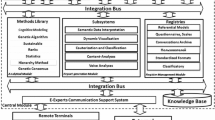Abstract
Collaborative computing is a new communication technology that makes it possible to extend model formulation, management, and analysis into a geographically distributed group environment. The forms of communication may vary from asynchronous hypermedia teamwork via the Internet to multipoint desktop video conferencing. The latter presents the maximal potential for integrating shared quantitative model analysis with real-time/asynchronous geographically distributed electronic meetings. Infeasibility diagnosis and reasoning on conflict resolution are known to be important parts of an evolving approach to linear programming model analysis. In the new distributed environment, several specific decision support issues related to infeasibility analysis emerge. One is the learning mechanism for capturing group knowledge on infeasibility resolution that is generated during the collaborative sessions of model analysis. The other new decision support component is a coordination protocol that is capable of linking individual activities and software transactions for the support of group reasoning on infeasibility analysis. This paper addresses these issues on the basis of committee models for infeasibility resolution and the neural network approach. Examples of modeling cases are based on experiments using a multiple criteria model for support of resource allocation in a distributed electronic meeting, and the case of model-based diagnosis that the group is involved in.
Similar content being viewed by others
References
R. Johansen,Groupware: Computer Support for Business Teams (MacMillan, 1988).
J.F. Nunamaker, R.O. Briggs and D.D. Mittleman, Electronic meeting systems: Ten years of lessons learned, in:Groupware: Technology and Applications, eds. D. Coleman and R. Khanna (Prentice-Hall, 1995) pp. 146–193.
S. Cosares, D.N. Deutsch, I. Sanice and O.J. Waseur, SONET Toolkit: A decision support system for designing robust and cost effective fiber-optic networks,Interfaces 25(1) (1995) 20–40.
D. Coleman and R. Khanna (eds.),Groupware: Technology and Applications (Prentice-Hall, 1995).
M.R. Gutkosky, R.E. Fikes, R.E. Genesereth, T.R. Gruber and W.S. Mark, PACT: An experiment in integrating concurrent engineering systems,IEEE Comp. 26 (1993) 28–37.
H.J. Greenberg, Rule-based intelligence to support linear programming analysis,Decision Support Syst. 9 (1993) 425–447.
H.J. Greenberg and F.H. Murphy, Approaches to diagnosing infeasibility for linear programs,ORSA J. Computing 3 (1991) 253–261.
H.J. Greenberg, How to analyze results of linear programs — Part 3: Infeasibility diagnosis,Interfaces 23(6) (1993) 120–139.
T.W. Malone and K. Crowston, The interdisciplinary study of coordination,ACM Comp. Surveys 26 (1994) 87–119.
J. Lees and R. Eberts, Performing team roles in computer-supported teamwork systems, School of Industrial Engineering, Purdue University, West Lafayette (1994).
A.B. Bordetsky and V.A. Tsygankov, Multiple objective decision making aid using analysis of inconsistency between constraints,Lecture Notes in Economics and Mathematical Systems, Vol. 351 (Springer, 1991) pp. 8–14.
J.W. Chinneck and W. Michalowski, MOLP formulation assistance using LP infeasibility analysis, SCE-94-17, Carleton University, Ottawa (1994).
G. Reeves and A. Bordetsky, A framework for interactive multiple criteria group decision support,Group Decision and Negotiation 4(2) (1994).
W. Lodwick, Preprocessing nonlinear functional constraints with applications to the pooling problem,ORSA J. Computing 4 (1992) 119–131.
H. Bhargava, R. Krishnan and A.B. Whinston, On integrating collaboration and decision analysis techniques,J. Organ. Computing 4 (1994) 297–316.
P.H. Winston,Artificial Intelligence (Addison-Wesley, 1992).
R.E. Steuer,Multiple Criteria Optimization (Wiley, 1986).
K. Terplan and J. Hantington-Lee,Applications for Distributed Systems and Network Management (ITP, 1994).
A. Bordetsky and M. Valtorta, Learning empirical constraints to complement diagnostic models,Intelligent Eng. Syst. Through Artificial Neural Networks 3 (1993) 97–102.
A. Bordetsky, Knowledge-based groupware for geographically distributed collaborative computing environments, Air Force Office of Scientific Research WPAFB, Dayton (1994).
H. Greenberg and F. Murphy, Views of mathematical programming models and their instances,Decision Support Syst. 13 (1995) 3–34.
J. Gleeson and J. Ryan, Identifying minimally infeasible subsystems of inequalities,ORSA J. Computing 2 (1990) 61–63.
J.W. Chinneck and E.W. Dravniecks, Locating minimal infeasible constraint sets in linear programs,ORSA J. Computing 3 (1991) 157–168.
M. Shaw and M. Fox, Distributed artificial intelligence for group decision support,Decision Support Syst. 9 (1993) 349–367.
V.M. Masurov, Decomposition in committee pattern recognition constructions,News of USSR Academy of Science, J. Comp. Syst. Sci. 4 (1992) 162–170.
A. Bordetsky and L. Kazarinov, Determining the committee of a system of weighted inequalities,Cybernetics, Ukraine Acad. Sci. 6 (1983) 766–772.
K. Watabe, C.W. Holsapple and A.B. Whinston, Coordinator support in nemawashi decision process,Decision Support Syst. 8 (1992) 85–98.
G.E. Kersten, A procedure for negotiating efficient and non-efficient compromises,Decision Support Syst. 4 (1988) 167–177.
K. Sycara, Machine learning for intelligent support of conflict resolution,Decision Support Syst. 10 (1993) 121–136.
CBR Express,User Guide (Inference Co., 1994).
J. Hsu and T. Lockwood, Collaborative computing,Byte (March, 1993) 113–120.
Author information
Authors and Affiliations
Rights and permissions
About this article
Cite this article
Bordetsky, A.B. Reasoning on infeasibility in distributed collaborative computing environment. Ann Math Artif Intell 17, 155–176 (1996). https://doi.org/10.1007/BF02284629
Issue Date:
DOI: https://doi.org/10.1007/BF02284629




